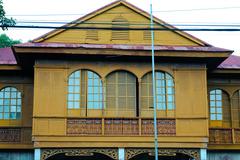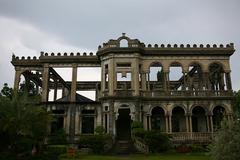Visiting San Sebastian Cathedral in Bacolod: Everything You Need to Know
Publication Date: 20/07/2024
Introduction to San Sebastian Cathedral
San Sebastian Cathedral, often referred to as Bacolod Cathedral, is one of Bacolod City’s most iconic landmarks. This historical and architectural marvel traces its origins back to the late 19th century and has since stood as a testament to the rich cultural heritage of the Philippines. Constructed initially as a modest chapel in 1825 by Recollect missionaries, the cathedral has evolved significantly over the decades. The current structure, whose construction began in 1876 under the supervision of Fr. Mauricio Ferrero, is a stunning blend of Romanesque and Gothic architectural styles. The cathedral’s imposing façade, twin bell towers, and intricate stone carvings are a visual treat for visitors (Diocese of Bacolod).
San Sebastian Cathedral’s significance extends beyond its architectural beauty. It has played a central role in the religious and cultural life of Bacolod City, serving as the seat of the Diocese of Bacolod since 1933. The cathedral has witnessed numerous historical events, including the challenges during World War II and subsequent restoration efforts in the 1950s. In recent years, the cathedral continues to be a focal point for religious celebrations, community gatherings, and cultural events such as the annual feast of San Sebastian (National Historical Commission of the Philippines).
This guide provides a comprehensive overview of San Sebastian Cathedral’s history, visitor information, and practical tips to enhance your visit. Whether you are a history enthusiast, a devout worshiper, or a curious tourist, this guide will help you appreciate the cathedral’s historical and cultural significance.
What You’ll Find in This Guide
- Introduction
- Early Beginnings and Establishment
- Construction of the Cathedral
- Consecration and Early Use
- World War II and Post-War Restoration
- Modern Developments and Renovations
- Visitor Information
- Opening Hours
- Ticket Prices
- Guided Tours
- Special Events
- Travel Tips
- Nearby Attractions
- Negros Museum
- Capitol Park and Lagoon
- The Ruins
- Notable Features and Artifacts
- Community Involvement and Activities
- Preservation Efforts
- FAQ
- Conclusion
Visiting San Sebastian Cathedral - History, Tickets, and Tips for Bacolod’s Iconic Landmark
Introduction
San Sebastian Cathedral, also known as Bacolod Cathedral, stands as a significant religious and historical landmark in Bacolod City, Philippines. With its rich history and stunning architecture, the cathedral draws both pilgrims and tourists alike. This guide will provide you with an in-depth look at the history of San Sebastian Cathedral, practical visitor information, and tips to enhance your visit.
Early Beginnings and Establishment
San Sebastian Cathedral’s origins date back to the late 19th century. Initially, it was a modest chapel built in 1825 by Recollect missionaries, who played a crucial role in spreading Christianity in the region. This chapel was dedicated to San Sebastian, the patron saint of Bacolod.
Construction of the Cathedral
The current cathedral’s construction began in 1876 under the supervision of Fr. Mauricio Ferrero, OAR, a Recollect priest. The community effort saw local parishioners contributing labor and materials, with coral stones sourced from Guimaras Island and hardwood from the forests of Negros. The architectural design blends Romanesque and Gothic styles, featuring an imposing façade, twin bell towers, and intricate stone carvings.
Consecration and Early Use
The cathedral was officially consecrated on January 20, 1882. It quickly became the center of religious activities in Bacolod, serving as the seat of the Diocese of Bacolod when it was established in 1933. The cathedral has since been a focal point for major religious events, including the annual feast of San Sebastian, which draws thousands of devotees.
World War II and Post-War Restoration
During World War II, the cathedral suffered significant damage, particularly to its bell towers, with one being completely destroyed. Post-war restoration efforts in the 1950s saw the reconstruction of the damaged bell tower and the reinforcement of the cathedral’s structure.
Modern Developments and Renovations
In the latter half of the 20th century, the cathedral underwent several renovations to accommodate the growing number of parishioners and to preserve its historical integrity. In 1976, the cathedral celebrated its centennial with a series of events and the unveiling of a commemorative marker. More recently, in 2012, the cathedral underwent a major renovation that included the installation of new stained glass windows, the refurbishment of the altar, and the enhancement of the lighting system to highlight its architectural features.
Visitor Information
Opening Hours
San Sebastian Cathedral is open to visitors daily from 6:00 AM to 8:00 PM.
Ticket Prices
Admission to the cathedral is free, but donations are welcome to support its maintenance and preservation.
Guided Tours
Guided tours are available and can be arranged through the cathedral’s office or the Diocese of Bacolod website. These tours provide detailed insights into the cathedral’s history and architecture.
Special Events
The annual feast of San Sebastian in January is a major event featuring processions, novenas, and cultural performances. Other notable events include Holy Week ceremonies and Christmas celebrations.
Travel Tips
- Best Time to Visit: Early mornings or late afternoons to avoid crowds.
- Dress Code: Modest attire is recommended as it is a place of worship.
- Photography: Allowed but be respectful of ongoing services and other visitors.
Nearby Attractions
- Negros Museum: Offers insights into the region’s history and culture.
- Capitol Park and Lagoon: A great place to relax and enjoy the outdoors.
- The Ruins: A popular tourist spot known for its picturesque remains of a mansion.
Notable Features and Artifacts
The cathedral houses several notable features and artifacts of historical and religious significance. The main altar, made of intricately carved wood, is a focal point of the cathedral’s interior. The twin bell towers, restored after World War II, are iconic landmarks. The cathedral also features a collection of religious statues and relics, including a statue of San Sebastian, venerated by the local community.
Community Involvement and Activities
San Sebastian Cathedral plays a vital role in the spiritual and social life of Bacolod City. It hosts regular masses, religious ceremonies, and community events. The cathedral is also involved in various charitable activities, providing support to the less fortunate members of the community. The annual feast of San Sebastian is a major event, featuring processions, novenas, and cultural performances that celebrate the city’s patron saint.
Preservation Efforts
Preserving the historical and architectural integrity of San Sebastian Cathedral is a priority for the local community and the Diocese of Bacolod. Efforts are continuously made to maintain and restore the cathedral, ensuring that it remains a significant landmark for future generations. These efforts include regular maintenance, structural assessments, and fundraising activities to support restoration projects.
FAQ Section
What are the visiting hours for San Sebastian Cathedral?
The cathedral is open daily from 6:00 AM to 8:00 PM.
How much are the tickets to San Sebastian Cathedral?
Admission is free, but donations are appreciated.
Are guided tours available?
Yes, guided tours can be arranged through the cathedral’s office or the Diocese of Bacolod website.
Conclusion
San Sebastian Cathedral is more than just a place of worship; it is a cultural and historical treasure in Bacolod City. Its rich history, stunning architecture, and active role in the community make it a must-visit destination. Whether you are a pilgrim or a tourist, the cathedral offers a unique glimpse into the city’s past and present.
Call to Action
For more information on visiting San Sebastian Cathedral, visit the official website of the Diocese of Bacolod. Don’t forget to check out other related posts and follow us on social media for updates and more travel tips.
References
- Diocese of Bacolod. (n.d.). Retrieved from Diocese of Bacolod
- National Historical Commission of the Philippines. (n.d.). San Sebastian Cathedral. Retrieved from NHCP
- Bacolod City Government. (n.d.). Historical Landmarks. Retrieved from Bacolod City Government

